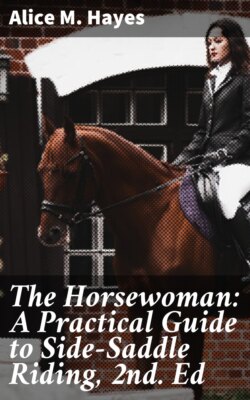Читать книгу The Horsewoman: A Practical Guide to Side-Saddle Riding, 2nd. Ed - Alice M. Hayes - Страница 9
На сайте Литреса книга снята с продажи.
SADDLE TREE.
ОглавлениеTable of Contents
The tree (Figs. 8, 9, 10, and 11) consists of two bars (side boards), which are connected together in front by the pommel, and behind by the cantle. The pommel is made up of a gullet plate, which is a steel arch that goes over the withers, and its coverings. The points of the tree are connected, one on each side, to the front ends of the bars and to the gullet plate, and they point downwards. The stirrup bar, which should be of a safety pattern, is attached to the near bar, a little lower down than the leaping head.
Fig. 9.—Underneath view of saddle tree.
The webs (Fig. 11) of a tree are strong hempen bands which cover the open space down the centre of the tree, and are nailed, at one end, to the pommel, and at the other end to the cantle. They are tightly stretched, in order to give the rider a comfortable seat, and to keep her weight off the horse’s backbone.
The office of the bars of the tree is to evenly distribute the rider’s weight, by means of the panel, over the muscles which run along each side of the horse’s backbone, and which form the only suitable bearing surfaces for the purpose in question. No weight should fall on the animal’s backbone, because it is very sensitive to pressure, even when the pressure is well distributed. In order to obtain this indispensable condition of evenly-distributed pressure, the bars of the tree of a saddle which is to be made for a particular horse, should accurately fit the bearing surfaces of the back upon which they rest, and should be well away from the backbone; in fact, the distance between the bars should not be less than four inches. When the rider is in the saddle, a fair amount of space should exist between the gullet plate and the withers, so that no injurious pressure may fall on the top or sides of the withers, which are particularly susceptible to inflammation from this cause.
In order to avoid giving an undue height to the pommel, with the object of keeping it off the withers, it should be “cut back” (Fig. 11), although this cutting back need not be carried to the excessive extent that is sometimes practised. In a man’s saddle, the pommel is generally straight.
Fig. 10.—Front view of saddle tree.
The points of the tree should accurately fit the parts upon which they rest, so as to prevent any “wobbling” of the saddle. The near point of the tree (Fig. 10) is usually made long, with the idea of helping the saddle to keep in its place; but if this is done, the off point should be comparatively short, because, if both points be long, they will be apt to become pulled further apart in the event of the horse turning round sharply, as he would have to do in a narrow stall, or even when refusing a jump.
The upper crutch, or, as it is called by saddlers, the near head, is a more or less upright projection which is placed on the near side of the pommel, in order to give support to the rider’s right leg. The slope and bearing surface of this near head should be regulated, so that (as we shall see further on) the lower part of the rider’s right leg may extend downwards along the shoulder of the horse, and that the lady may be able to exert full pressure against the near head, by the inward rotation of her thigh (p. 157). The height of the near head depends on the thickness of the rider’s thigh, because a fat leg will require a higher crutch than a thin one. If the upper crutch be unduly long, it will push the skirt up and give it a bad appearance. We must, however, bear in mind that if it is too short for its legitimate purpose, it will afford an insecure grip to the right leg, which is a consideration that must not be neglected.
Before the leaping head (p. 33) was invented, side-saddles were provided with an off crutch, which was placed on the off side of the pommel. In a very old saddle which I saw, it took the form of an upright handle, which was placed parallel to the direction of the withers, and which apparently was intended to be grasped by the right hand of the rider in case of emergency. In a saddle of mine, which is about 100 years old, the off crutch projects horizontally to the right. Fifty years ago, the off crutch was almost always upright, and was often placed so close to the near crutch that the rider was able to get a fairly firm support for her right leg by jamming it between these two crutches. As the great utility of the leaping head received increasingly wide recognition, the off crutch underwent a gradual process of decadence, because it is of no benefit to a rider who understands the use of a leaping head. Indications of its previous existence may occasionally be seen, especially abroad, in the form of an entirely useless thickening of the off side of the pommel.
Fig. 11.—Underneath view of saddle tree and its webs.
